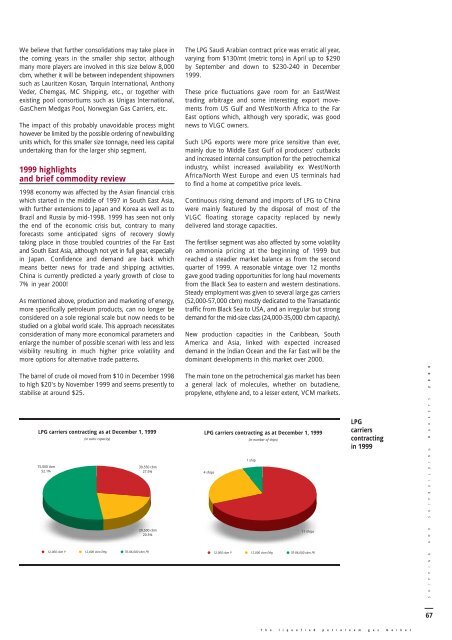You also want an ePaper? Increase the reach of your titles
YUMPU automatically turns print PDFs into web optimized ePapers that Google loves.
We believe that further consolidations may take place in<br />
the coming years in the smaller ship sec<strong>to</strong>r, although<br />
many more players are involved in this size below 8,000<br />
cbm, whether it will be between independent shipowners<br />
such as Lauritzen Kosan, Tarquin International, Anthony<br />
Veder, Chemgas, MC Shipping, etc., or <strong>to</strong>gether with<br />
existing pool consortiums such as Unigas International,<br />
GasChem Medgas Pool, Norwegian Gas Carriers, etc.<br />
The impact of this probably unavoidable process might<br />
however be limited by the possible ordering of newbuilding<br />
units which, for this smaller size <strong>to</strong>nnage, need less capital<br />
undertaking than for the larger ship segment.<br />
1999 highlights<br />
and brief commodity review<br />
1998 economy was affected by the Asian financial crisis<br />
which started in the middle of 1997 in South East Asia,<br />
with further extensions <strong>to</strong> Japan and Korea as well as <strong>to</strong><br />
Brazil and Russia by mid-1998. 1999 has seen not only<br />
the end of the economic crisis but, contrary <strong>to</strong> many<br />
forecasts some anticipated signs of recovery slowly<br />
taking place in those troubled countries of the Far East<br />
and South East Asia, although not yet in full gear, especially<br />
in Japan. Confidence and demand are back which<br />
means better news for trade and shipping activities.<br />
China is currently predicted a yearly growth of close <strong>to</strong><br />
7% in year 2000!<br />
As mentioned above, production and marketing of energy,<br />
more specifically petroleum products, can no longer be<br />
considered on a sole regional scale but now needs <strong>to</strong> be<br />
studied on a global world scale. This approach necessitates<br />
consideration of many more economical parameters and<br />
enlarge the number of possible scenari with less and less<br />
visibility resulting in much higher price volatility and<br />
more options for alternative trade patterns.<br />
The barrel of crude oil moved from $10 in December 1998<br />
<strong>to</strong> high $20's by November 1999 and seems presently <strong>to</strong><br />
stabilise at around $25.<br />
LPG carriers contracting as at December 1, 1999<br />
75,000 cbm<br />
52.1%<br />
(in cubic capacity)<br />
39,550 cbm<br />
27.5%<br />
29,500 cbm<br />
20.5%<br />
12,000 cbm P 12,000 cbm Ethy 70-86,000 cbm FR<br />
The LPG Saudi Arabian contract price was erratic all year,<br />
varying from $130/mt (metric <strong>to</strong>ns) in April up <strong>to</strong> $290<br />
by September and down <strong>to</strong> $230-240 in December<br />
1999.<br />
These price fluctuations gave room for an East/West<br />
trading arbitrage and some interesting export movements<br />
from US Gulf and West/North Africa <strong>to</strong> the Far<br />
East options which, although very sporadic, was good<br />
news <strong>to</strong> VLGC owners.<br />
Such LPG exports were more price sensitive than ever,<br />
mainly due <strong>to</strong> Middle East Gulf oil producers' cutbacks<br />
and increased internal consumption for the petrochemical<br />
industry, whilst increased availability ex West/North<br />
Africa/North West Europe and even US terminals had<br />
<strong>to</strong> find a home at competitive price levels.<br />
Continuous rising demand and imports of LPG <strong>to</strong> China<br />
were mainly featured by the disposal of most of the<br />
VLGC floating s<strong>to</strong>rage capacity replaced by newly<br />
delivered land s<strong>to</strong>rage capacities.<br />
The fertiliser segment was also affected by some volatility<br />
on ammonia pricing at the beginning of 1999 but<br />
reached a steadier market balance as from the second<br />
quarter of 1999. A reasonable vintage over 12 months<br />
gave good trading opportunities for long haul movements<br />
from the Black Sea <strong>to</strong> eastern and western destinations.<br />
Steady employment was given <strong>to</strong> several large gas carriers<br />
(52,000-57,000 cbm) mostly dedicated <strong>to</strong> the Transatlantic<br />
traffic from Black Sea <strong>to</strong> USA, and an irregular but strong<br />
demand for the mid-size class (24,000-35,000 cbm capacity).<br />
New production capacities in the Caribbean, South<br />
America and Asia, linked with expected increased<br />
demand in the Indian Ocean and the Far East will be the<br />
dominant developments in this market over 2000.<br />
The main <strong>to</strong>ne on the petrochemical gas market has been<br />
a general lack of molecules, whether on butadiene,<br />
propylene, ethylene and, <strong>to</strong> a lesser extent, VCM markets.<br />
LPG carriers contracting as at December 1, 1999<br />
4 ships<br />
(in number of ships)<br />
1 ship<br />
11 ships<br />
12,000 cbm P 12,000 cbm Ethy 70-86,000 cbm FR<br />
LPG<br />
carriers<br />
contracting<br />
in 1999<br />
T h e l i q u e f i e d p e t r o l e u m g a s m a r k e t<br />
S H I P P I N G A N D S H I P B U I L D I N G M A R K E T S 2 0 0 0<br />
67


